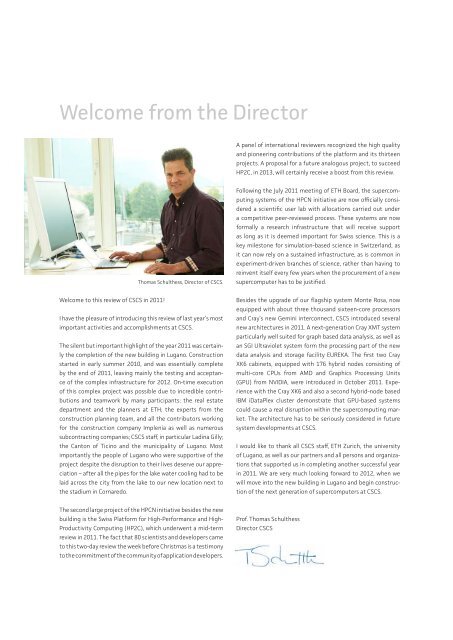Annual Report 2011 - CSCS
Annual Report 2011 - CSCS
Annual Report 2011 - CSCS
You also want an ePaper? Increase the reach of your titles
YUMPU automatically turns print PDFs into web optimized ePapers that Google loves.
Welcome from the Director<br />
Welcome to this review of <strong>CSCS</strong> in <strong>2011</strong>!<br />
Thomas Schulthess, Director of <strong>CSCS</strong>.<br />
I have the pleasure of introducing this review of last year’s most<br />
important activities and accomplishments at <strong>CSCS</strong>.<br />
The silent but important highlight of the year <strong>2011</strong> was certainly<br />
the completion of the new building in Lugano. Construction<br />
started in early summer 2010, and was essentially complete<br />
by the end of <strong>2011</strong>, leaving mainly the testing and acceptance<br />
of the complex infrastructure for 2012. On-time execution<br />
of this complex project was possible due to incredible contributions<br />
and teamwork by many participants: the real estate<br />
department and the planners at ETH; the experts from the<br />
construction planning team, and all the contributors working<br />
for the construction company Implenia as well as numerous<br />
subcontracting companies; <strong>CSCS</strong> staff, in particular Ladina Gilly;<br />
the Canton of Ticino and the municipality of Lugano. Most<br />
importantly the people of Lugano who were supportive of the<br />
project despite the disruption to their lives deserve our appreciation<br />
– after all the pipes for the lake water cooling had to be<br />
laid across the city from the lake to our new location next to<br />
the stadium in Cornaredo.<br />
The second large project of the HPCN initiative besides the new<br />
building is the Swiss Platform for High-Performance and High-<br />
Productivity Computing (HP2C), which underwent a mid-term<br />
review in <strong>2011</strong>. The fact that 80 scientists and developers came<br />
to this two-day review the week before Christmas is a testimony<br />
to the commitment of the community of application developers.<br />
A panel of international reviewers recognized the high quality<br />
and pioneering contributions of the platform and its thirteen<br />
projects. A proposal for a future analogous project, to succeed<br />
HP2C, in 2013, will certainly receive a boost from this review.<br />
Following the July <strong>2011</strong> meeting of ETH Board, the supercomputing<br />
systems of the HPCN initiative are now officially considered<br />
a scientific user lab with allocations carried out under<br />
a competitive peer-reviewed process. These systems are now<br />
formally a research infrastructure that will receive support<br />
as long as it is deemed important for Swiss science. This is a<br />
key milestone for simulation-based science in Switzerland, as<br />
it can now rely on a sustained infrastructure, as is common in<br />
experiment-driven branches of science, rather than having to<br />
reinvent itself every few years when the procurement of a new<br />
supercomputer has to be justified.<br />
Besides the upgrade of our flagship system Monte Rosa, now<br />
equipped with about three thousand sixteen-core processors<br />
and Cray’s new Gemini interconnect, <strong>CSCS</strong> introduced several<br />
new architectures in <strong>2011</strong>. A next-generation Cray XMT system<br />
particularly well suited for graph based data analysis, as well as<br />
an SGI Ultraviolet system form the processing part of the new<br />
data analysis and storage facility EUREKA. The first two Cray<br />
XK6 cabinets, equipped with 176 hybrid nodes consisting of<br />
multi-core CPUs from AMD and Graphics Processing Units<br />
(GPU) from NVIDIA, were introduced in October <strong>2011</strong>. Experience<br />
with the Cray XK6 and also a second hybrid-node based<br />
IBM iDataPlex cluster demonstrate that GPU-based systems<br />
could cause a real disruption within the supercomputing market.<br />
The architecture has to be seriously considered in future<br />
system developments at <strong>CSCS</strong>.<br />
I would like to thank all <strong>CSCS</strong> staff, ETH Zurich, the university<br />
of Lugano, as well as our partners and all persons and organizations<br />
that supported us in completing another successful year<br />
in <strong>2011</strong>. We are very much looking forward to 2012, when we<br />
will move into the new building in Lugano and begin construction<br />
of the next generation of supercomputers at <strong>CSCS</strong>.<br />
Prof. Thomas Schulthess<br />
Director <strong>CSCS</strong>


